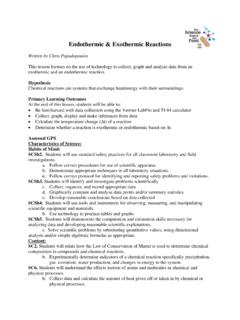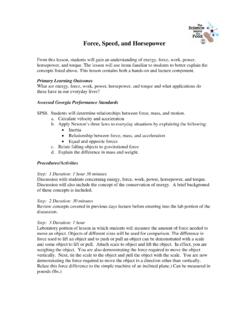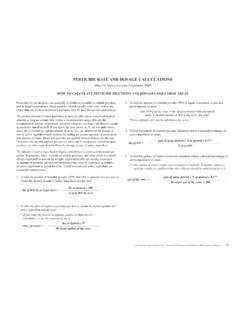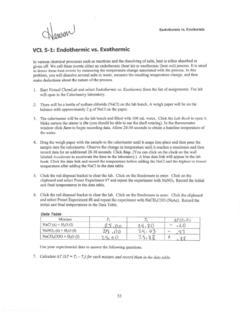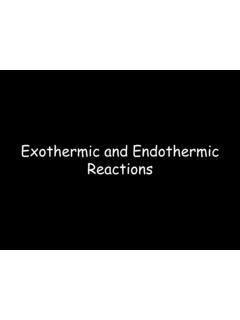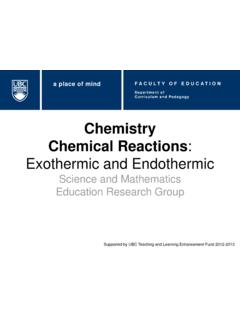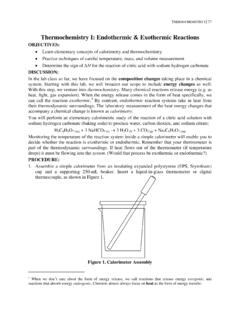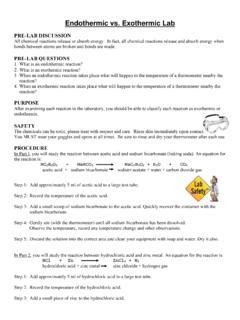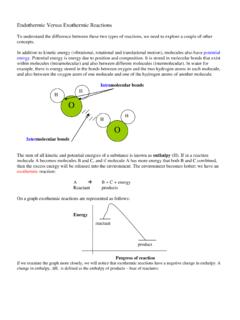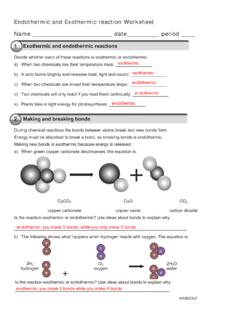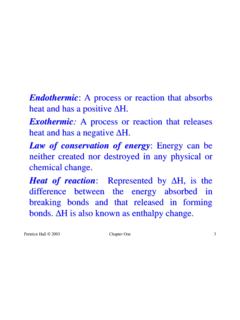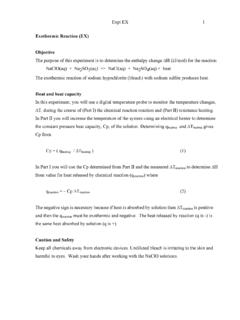Transcription of Endothermic & Exothermic Reactions - UGA Extension
1 Endothermic & Exothermic Reactions Written by Chris Papadopoulos This lesson focuses on the use of technology to collect, graph and analyze data from an Exothermic and an Endothermic reaction. Hypothesis Chemical Reactions are systems that exchange heat/energy with their surroundings. Primary Learning Outcomes At the end of this lesson, students will be able to: Be familiarized with data collection using the Vernier LabPro and TI-84 calculator Collect, graph, display and make inferences from data Calculate the temperature change ( t) of a reaction Determine whether a reaction is Exothermic or Endothermic based on t Assessed GPS Characteristics of Science: Habits of Mind: SCSh2.
2 Students will use standard safety practices for all classroom laboratory and field investigations. a. Follow correct procedures for use of scientific apparatus. b. Demonstrate appropriate techniques in all laboratory situations. c. Follow correct protocol for identifying and reporting safety problems and violations. SCSh3. Students will identify and investigate problems scientifically c. Collect, organize, and record appropriate data d. Graphically compare and analyze data points and/or summary statistics e. Develop reasonable conclusions based on data collected SCSh4. Students will use tools and instruments for observing, measuring, and manipulating scientific equipment and materials.
3 B. Use technology to produce tables and graphs SCSh5. Students will demonstrate the computation and estimation skills necessary for analyzing data and developing reasonable scientific explanations. e. Solve scientific problems by substituting quantitative values, using dimensional analysis and/or simple algebraic formulas as appropriate. Content: SC2. Students will relate how the Law of Conservation of Matter is used to determine chemical composition in compounds and chemical Reactions . b. Experimentally determine indicators of a chemical reaction specifically precipitation, gas evolution, water production, and changes in energy to the system.
4 SC6. Students will understand the effects motion of atoms and molecules in chemical and physical processes. b. Collect data and calculate the amount of heat given off or taken in by chemical or physical processes. Duration 85 minutes Materials and Equipment Styrofoam cup 250-mL baker citric acid, H3C6H5O7, solution baking soda, NaHCO3 hydrochloric acid, HCl, solution 50-mL graduated cylinder Technology Connection Vernier LabPro interface TI Graphing Calculator Vernier DataMate program Vernier Temperature Probe Procedures Step 1: Introduction/Motivation, 15 minutes Light a match/Bunsen burner/lighter. Question students as to what is happening.
5 Write answers on the board. Discuss demonstration, write the chemical reaction on the board. (Write Equation Here) Lead a discussion on some common Exothermic and Endothermic Reactions . Elicit examples from students and provide additional examples. Examples include: Mixture of cement and water ( Exothermic ) Melting and freezing of ice ( Endothermic and Exothermic ) Baking soda and water ( Exothermic ) Hot packs and cold packs ( Endothermic , Endothermic ) Define terms and list on board (students write in notebooks). Teacher may elaborate as desired. In an Endothermic process, a system absorbs heat from its surroundings. Chemical Reactions that absorb energy are Endothermic Reactions .
6 In an Exothermic process, a system releases heat to its surroundings. Chemical Reactions that release energy are Exothermic Reactions . For example, the calcium oxide in cement: CaO(s) + H2O(l) -> Ca(OH)2(s) + kJ. Show students what the set up should look like, including proper initialization of the Vernier LabPro and TI calculator. Step 2: Activity, 50 minutes Students will break up into groups and conduct activity Endothermic and Exothermic Reactions as outlined in student handout. Step 3: Review, 20 minutes Gather students as a class and discuss results, answers to the review questions given at the end of the student handout, and any problems or questions with the procedure.
7 Assessment Completed student worksheets will be collected and graded. Student understanding of activity components may be assessed by unit examination. Student affect and work ethic may be assessed by affect/ethic rubric. References Holmquist, , Randall, J. & Volz, D. (2000). Chemistry with Calculators. pp. 1-1 1-T3. Vernier Software & Technology: Beaverton, Oregon. Endothermic & Exothermic Reactions Many chemical Reactions give off energy. Chemical Reactions that release energy are called Exothermic Reactions . Some chemical Reactions absorb energy and are called Endothermic Reactions . You will study one Exothermic and one Endothermic reaction in this experiment.
8 In Part I, you will study the reaction between citric acid solution and baking soda. An equation for the reaction is: H3C6H5O7(aq) + 3 NaHCO3(s) 3 CO2(g) + 3 H2O(aq) + Na3C6H5O7(aq) In Part II, you will study the reaction between magnesium metal and hydrochloric acid. An equation for this reaction is: Mg(s) + 2 HCl(aq) H2(g) + MgCl2(aq) Another objective of this experiment is for you to become familiar with using the DataMate data-collection program on the TI Graphing Calculator. In this experiment, you will use the program to collect and display data as a graph or list, to examine your experimental data values on a graph, and to print graphs and data lists.
9 Figure 1 MATERIALS LabPro interface Styrofoam cup TI Graphing Calculator 250-mL baker DataMate program citric acid, H3C6H5O7, solution Temperature Probe baking soda, NaHCO3 50-mL graduated cylinder hydrochloric acid, HCl, solution balance magnesium, Mg PROCEDURE 1. Obtain and wear goggles. Part I Citric Acid plus Baking Soda 2. Plug the Temperature Probe into Channel 1 of the LabPro or CBL 2 interface. Use the link cable to connect the TI Graphing Calculator to the interface.
10 Firmly press in the cable ends. 3. Place a Styrofoam cup into a 250-mL beaker as shown in Figure 1. Measure out 30 mL of citric acid solution into the Styrofoam cup. Place the Temperature Probe into the citric acid solution. 4. Weigh out g of solid baking soda on a piece of weighing paper. 5. Turn on the calculator and follow these steps to start the DATAMATE program. TI-73 and TI-83 Calculators: Press PRGM, then press the calculator key for the number that precedes the DATAMATE program (usually 1). Press ENTER. You are now at the main screen of the program. Press CLEAR to reset the program. TI-83 Plus Calculators: Press APPS, then press the calculator key for the number that precedes the DATAMATE program.
